|
|
|
Clark County Press, Neillsville, WI September 28, 1994, Page 28 Transcribed by Dolores (Mohr) Kenyon. Index of "Good Old Days" Articles
|
|
|
|
Clark County Press, Neillsville, WI September 28, 1994, Page 28 Transcribed by Dolores (Mohr) Kenyon. Index of "Good Old Days" Articles
|
Good Old Days
By Dee Zimmerman
In November 1889, the Clark County Board of Supervisors passed a resolution authorizing the compilation, publication and circulation of 7,000 copies of a book descriptive of the resources of the county.
Quoting from the publication, “Acting upon this recommendation we have sought to avoid all false or misleading statements, and if there is a false statement in this work, it is due to lack of knowledge on our part rather than to any intention to deceive.” Then they entitled the publication “Clark County, the Garden of Wisconsin.” There are some area residents who still have a copy of the publication, having been passed down through their families.
Members of the County Board were; Ira Fike (Chairman), E. W. Romaine, Ambrose Steinwand, Oscar Fricke, F. J. Vine, Wm. Sommer, W. R. Adkins, Joseph Gibson, A. B. Matthias, D. A. Neff, H. S. Mulvey, Ernest Sternitzky, Orin Wilson, E. H. Winchester, Ezra Tompkins, John L. Sullivan, C. M. Bradford, John Adams, Cullen Ayer, W. H. Mead, Asa Morton, Fred Seif, Thos. Dunn, C. H. Ide, A. B. Marsh, R. F. Kountz and Herman Schuster.
The booklet was published in hopes of encouraging people to settle in Clark County, (to) make it their new home site.
Clark County, situated a little northwest of the center of the State of Wisconsin, was created out of territory taken from Jackson County in 1853. The county contained 34 townships of 36 square miles each, giving it an area of 1,224 square miles, extending 42 miles north and south and 30 miles east and west. For the purposes of local government, the county was divided into 24 towns.
Looking at the outline of Clark County, some may wonder why there is a six-by-six mile chunk out of the southwestern corner of the otherwise mostly oblong border.
A politician, W. T. Price of Black River Falls, was looking after his fences at home. Price was an influential early-day congressman. He believed that with the Green Bay Railroad traveling east and west, and the North Western railroad going north and south, both crossing at Merrillan that the community would eventually become an important, flourishing city. He speculated right.
Therefore, Price was wholeheartedly in favor of putting Merrillan into Jackson County. With the southern section of Clark County but sparsely settled, there was little or no opposition.
Thus, the southwestern corner of Clark County containing Merrillan became the upped (upper) half of the Town of Alma, Jackson County.
The territory comprising Clark County was first settled as early as 1844, principally by men who were attracted here by the immense pine forests, accessible by the Black River and its tributaries, its eastern part by tributaries of the Wisconsin River, and the western part by the Eau Claire River, as well as effluents of the Chippewa River. The Black River divided the county into two nearly equal parts.
At that time, the county was surrounded by railways in its neighboring counties, but plans were under way with three railway branches to start grading lines across the county. That was believed to be a promising boost in the growing development of the county, being a direct communication with cities of Chicago, Milwaukee and the Twin Cities (St. Paul and Minneapolis). Giving it a market for its varied products as well as receiving merchandise with little expense in transportation was to be a selling point in luring land buyers.
In 1870 the County’s population was 3,450; in 1875 it was 7,283, in 1880 it was 10,715, and in 1885 it was 15,423.
Some of the selling points listed were:
“The Black River with many rapids, an average fall of fifteen feet to the mile, giving the area through which it passes an abundance of water power. This power can be easily and profitably utilized in the manufacturing of the immense supply of hardwood timber, etc.”
“Farming, stock raising and dairy farming will have an abundant supply of pure water, its rich soil with 35 bushels per acre of wheat is grown, four tons of hay per acre, 50 to 90 bushels of oats per acre, 40 to 70 bushels of barley per acre, 150 to 300 bushels of potatoes per acre, rich pasture lands – we see no reason why Clark County will not, within 10 years, be one of the richest agriculture counties in the Northwest.”
“We have a climate that is as healthful and pleasant as one could wish for…”
(They really were promoting Clark County, weren’t they?)
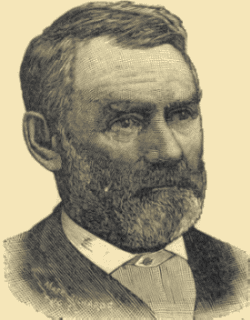 |
H. N. Withee
Born in Maine, Withee lived most of his life in Wisconsin and Clark County. Prior to living here, he had been a school teacher. Withee had a small farm along North Grand Avenue, the land running west to Black River, and a larger farm a few miles from the city. Serving first as deputy county treasurer, he was elected to the office of treasurer in the mid 1880s.
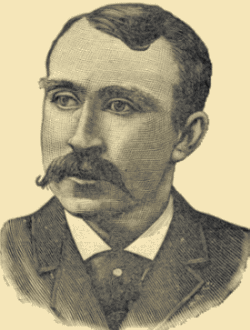 |
G. E. Crothers
Living his boyhood on a farm in Adams County, Crothers came to Clark County in 1884. Having taught school in Adams County, he resumed his teaching career here, living in Thorp. He was elected County Superintendent of Schools in 1889.
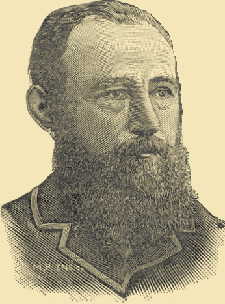 |
William Zassenhaus
Immigrating from Germany in 1865, Zassenhaus went to Iowa for one year and then to Wisconsin. For several years his business was that of a miner and explorer in the Lake Superior mining region. Some mining expeditions had led him to Nevada and Australia, also. Later, he settled in the Town of Green Grove, in 1877, where he started farming and a mercantile business. After being elected County Register of Deeds, he took up temporary residence in Neillsville.
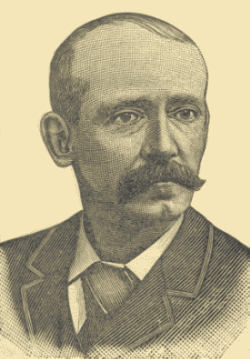 |
Homer M. Root
Root came to Clark County in 1869, a native of Chenango County, N. Y., was engaged in the lumbering business. In 1874 he went into partnership with B. F. Thompson, together the firm had an extensive logging operation in the northern part of the county. He resided on a large farm in the Town of Warner, near the village of Greenwood. In 1888 he was elected County Clerk.
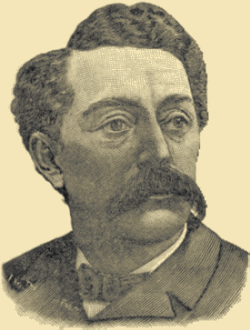 |
C. S. Stockwell
In 1845, Stockwell left St. Claire County, Mich., arriving at Onalaska, Wis., where he taught school for two years. He was elected County Superintendent of Schools at La Crosse County in 1877 serving until 1881. Employed by the La Crosse Lumber Co., he came to Clark County in 1882, where he purchased land in the Town of Sherwood Forest and became a resident there. Stockwell was elected Clerk of Circuit Court in 1888.
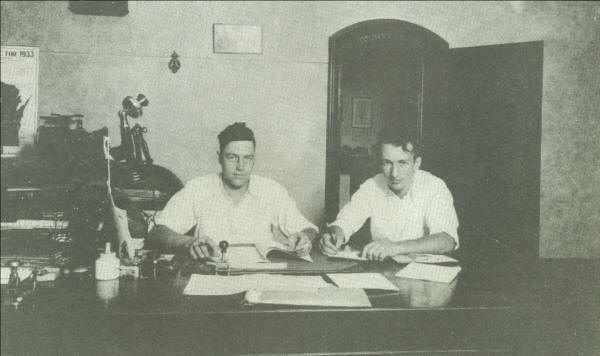 |
Clark County Clerk’s Office – 1933
Anyone having business at the Clark County Clerk’s office in 1933 would have been served by these two gentlemen. Calvin Mills, left, was elected to the office of Clark County Clerk in 1932. He served in that capacity until 1945 when he was appointed Superintendent of the Clark County Hospital at Owen, retiring from that position in 1969.
Henry Rahn, at the right, a resident of the Township of Green Grove, was appointed Deputy County Clerk by Calvin Mills, a position he held for 4 years. Rahn graduated from the University of Wisconsin, Madison, with a major in business administration and accounting, prior to his appointment. That was during the Great Depression, when employment was very difficult to find for everyone. Young Rahn felt very fortunate to have the job and salary of $75 per month. He later was elected Register of Deeds, where he worked for 26 years, resigning in 1963 to become Auditor controller and Asst Adm. of the Neillsville Memorial Hospital and Home, retiring in 1973. (Photo courtesy of Mrs. Henry Rahn)
|
© Every submission is protected by the Digital Millennium Copyright Act of 1998.
Show your appreciation of this freely provided information by not copying it to any other site without our permission.
Become a Clark County History Buff
|
|
A site created and
maintained by the Clark County History Buffs
Webmasters: Leon Konieczny, Tanya Paschke, Janet & Stan Schwarze, James W. Sternitzky,
|